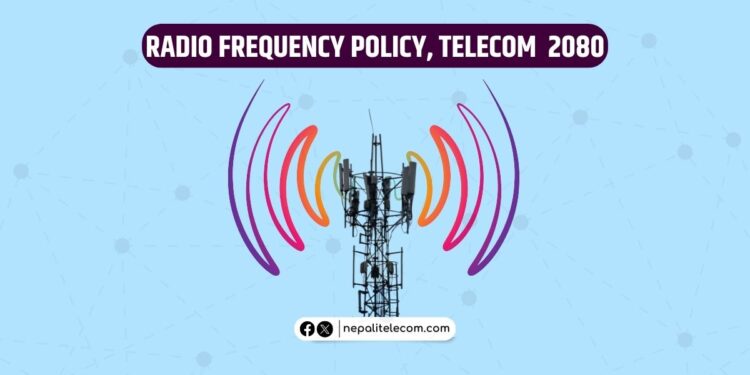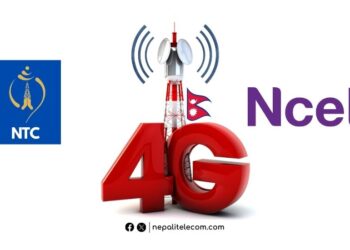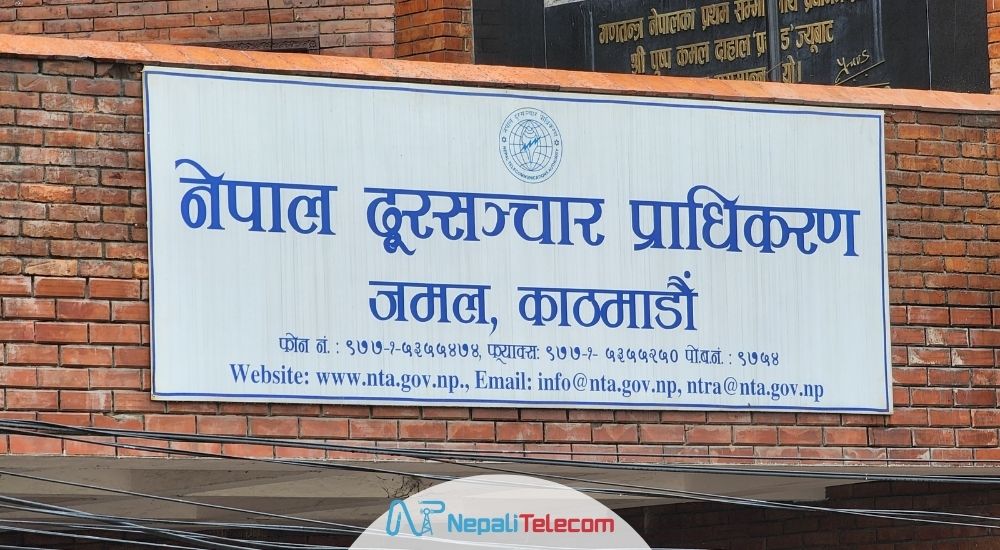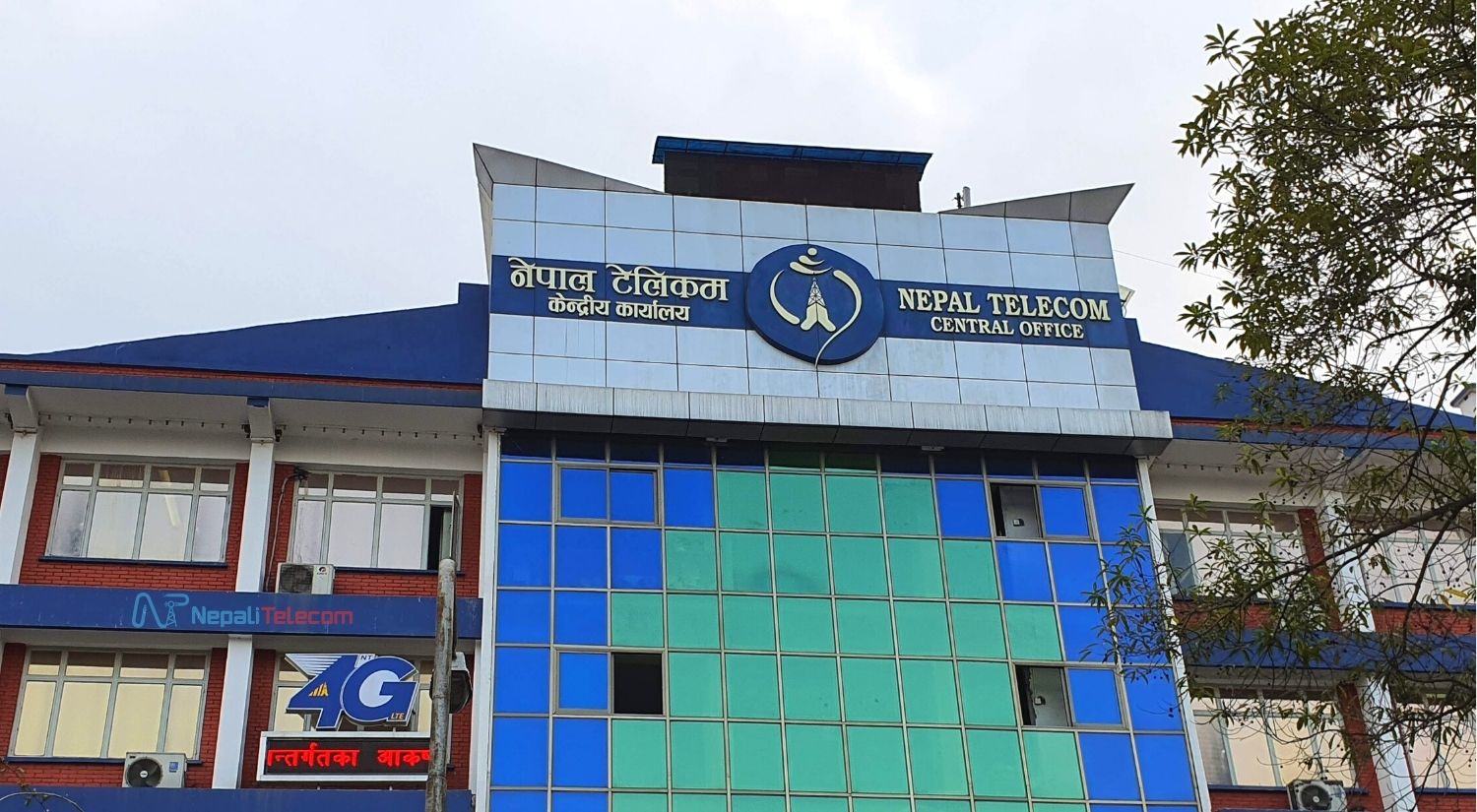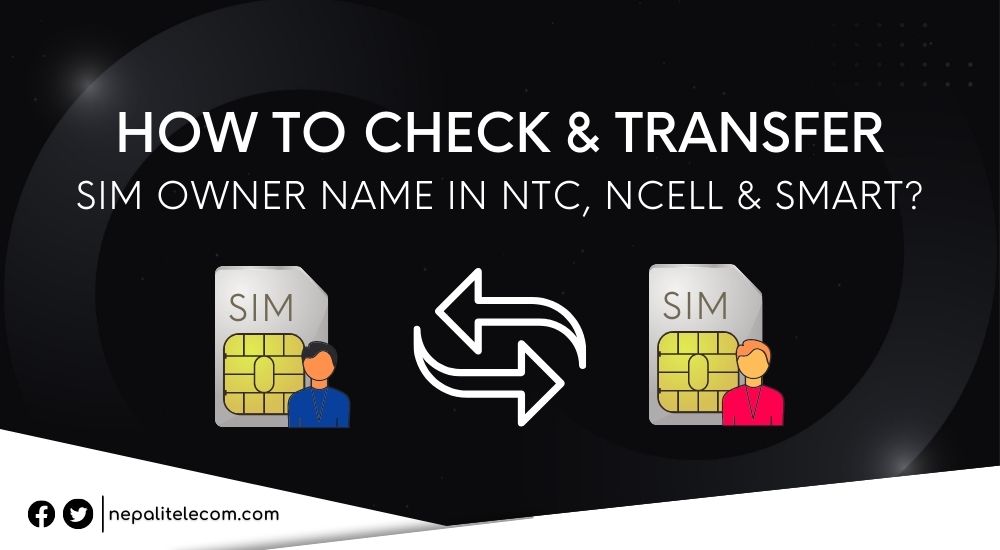The Radio Frequency Policy Determination Committee headed (RFPDC) by Communication Minister Rekha Sharma has passed the Radio Frequency Policy for Telecom Services 2080. The policy that guides the operation and use of frequency and allocation was prepared by the Nepal Telecommunication Authority (NTA) and approved by the board’s 29th meeting on 2080-06-30 before being sent to the MoCIT.
As per practice, the RFPDC tells the telecom regulator NTA to devise a national frequency strategy. NTA forms a committee with experts on the subject matter and formulates the policy which first goes to its board. Once it passes from the board, the RFPDC reviews it and keeps the right to approve it which follows a thorough review by the experts in the committee. Traditionally, the MoCIT Minister presides as the chairperson for the Radio Frequency Policy Determination Committee. The radio frequency policy aims to make frequency allocation transparent, effective use of resources, ensure basic communication services across Nepal, and encourage the growth of 4G and 5G. The policy also aims to create a level playing field for all telecom service providers. Section 49 of the Telecommunications Act, 2053 states the provisions for the national frequency policies.
Radio Frequency Policy for Telecom Services 2080: All You Need to Know
- Top features of the Radio Frequency Policy for Telecom Services 2080
- Mobile service frequency through auction
- Cellular/mobile frequency prices determined
- Multiple of 5 MHz
- Minimum, additional, and maximum frequency
- Mobile frequency fee
- Fee of additional mobile frequency allocated before the implementation of Technology neutrality
- Encouraging 5G growth
- Radio Frequency Policy in essence
Top features of the Radio Frequency Policy for Telecom Services 2080
The radio frequency policy aims at giving companies a level playing field and promotes technology neutrality. It also aims at making the resource allocation transparent, and effective for its maximum use. Here are the key highlights of the Radio Frequency Policy for Telecommunication Services 2080:
- NTA’s new telecom frequency policy, 2080 aims at making frequency allocation more able, effective, transparent, and properly managing its price determination. Likewise, it also ensures similar service providers a level playing field promoting technology neutrality for the effective delivery of innovative services. The idea is to bring forth competitive services.
- Identify existing and new frequencies and determine minimum and maximum bandwidth limits for service providers.
- Allocate Frequency bandwidth in a multiple of 5 MHz.
- 3700 MHz in the basket (most probably for 5G), which needs to be allotted keeping the satellite frequency band (Fixed satellite service). 26GHz (mmwave) is also listed for 5G.
- Synchronization of CPE and Handsets (End-user device) to the currently deployed mobile network and make provision to import/use such efficient devices only.
- Spectrum Trading and Spectrum Sharing Not allowed.
- Base price determined for the different spectrum bands, based on technology maturity, and band ecosystem.
- Ensure innovative and reliable telecom service access to the customers.
- Contribute to studies and research to address topics related to Nepal’s frequencies in international forums.
- Operators are not allowed to use frequency other than the allotted and not to create interference with other operators.
- Make necessary arrangements to monitor and reduce the Cross-Border Interference.
- The unlicensed band defined for non-cellular IoT & short-range communication.
Check out: Frequency bands in Nepal for Cellular technology (2G, 3G, 4G, 5G)
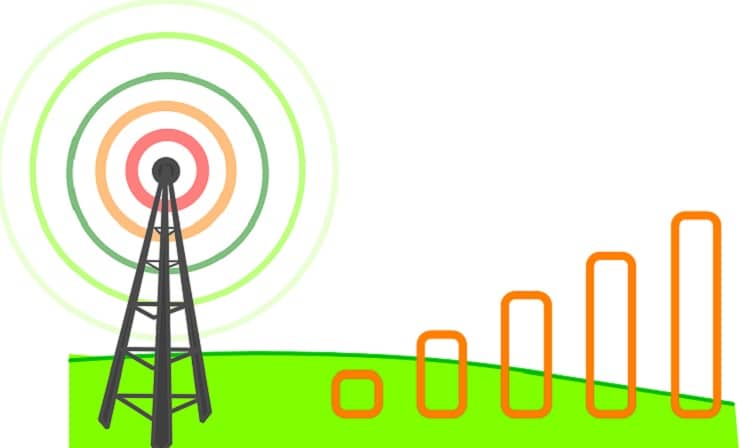
Mobile service frequency through auction
As usual, NTA’s new telco frequency policy states that mobile/cellular frequency will be allocated to service providers through auction. Meanwhile, technology neutrality will be promoted to ensure maximum use of frequency and the maximum utilization of innovative technologies. As per this technology, any generation of technology and service can be established on any frequency band. The policy also adds that frequency sale and distribution won’t be allowed through spectrum trading or spectrum sharing.
Spectrum will be refarmed
The spectrum will be refarmed to ensure maximum frequency use as per the existing practice in regional and international markets. The frequency will be capped to determine the base and maximum band required to provide communication services. While refarming, NTA will try to maintain a contiguous spectrum for the optimum utilization of the frequency.
Basis for radio frequency charges
NTA will fix charges for the radio frequency on primarily the following basis:
- Characteristics of technology used in radio frequency (mobile, microwave, satellite, etc.) such as signal propagation characteristics, radio coverage, and spectral efficiency,
- Investment in infrastructure setup, equipment, and ecosystem development,
- Demand and availability of radio frequency,
- Market price in international markets, per capita income, etc.
Cellular/mobile frequency prices determined
The policy has determined provisions for the allocation of radio frequency as per ITU’s Radio Regulations and international practices. Likewise, frequency band, bandwidth, and minimum and maximum bandwidth have also been fixed.
As the policy has, frequency exceeding the maximum frequency bandwidth in each band won’t be issued to any service provider. Additional frequency won’t be provided to service providers unless they obtain the basic telephony license. Additionally, they won’t get the approval for spectrum neutrality.
Check out: How to check 4G and 5G band support on your smartphone?
Multiple of 5 MHz
The policy holds that any service provider, if adopts technology neutrality, will be allocated multiple of five x5 MHz frequency. If any service provider’s total frequency exceeds the multiple of 5MHz, it shall be returned to the authority. As per the policy, frequencies that are already auctioned off or allotted without the multiple of five x5 MHz will get the frequencies as per the same principle. If additional frequencies are demanded under the same policy, such frequencies shall be allotted not exceeding the maximum threshold. For example: Currently, Ntc and Ncell hold 9.6 MHz of frequency in 900 MHz, now afterward NTA will award 0.4 MHz to both of the operators to make it 10 MHz.
| Frequency band | Duplexing | Frequency Range | Available Bandwidth | Minimum Bandwidth | Maximum Bandwidth | |
| 700 MHz | F D D | UL | 703-748 MHz | 2×45 MHz | 2×5 MHz | 2×15 MHz |
| DL | 758-803 MHz | |||||
| 800 MHz | UL | 847-862 MHz | 2×15 MHz | 2×5 MHz | 2×15 MHz | |
| DL | 806-821 MHz | |||||
| 850 MHz | UL | 824-834 MHz | 2×10 MHz | 2×5 MHz | 2×10 MHz | |
| DL | 869-879 MHz | |||||
| 900 MHz | UL | 880-915 MHz | 2×35 MHz | 2×5 MHz | 2×10 MHz | |
| DL | 925-960 MHz | |||||
| 1800 MHz | UL | 1710-1785 MHz | 2×75 MHz | 2×10 MHz | 2×20 MHz | |
| DL | 1805-1880 MHz | |||||
| 2100 MHz | UL | 1920-1980 MHz | 2×60 MHz | 2×10 MHz | 2×20 MHz | |
| DL | 2110-2170 MHz | |||||
| 2300 MHz | TDD | 2300-2400 MHz | 100 MHz | 20 MHz | 100 MHz | |
| 2600 MHz | 250-2690 MHz | 190 MHz | 20 MHz | 100 MHz | ||
| 3700 MHz | 3300-4200 MHz | 900 MHz | 100 MHz | 200 MHz | ||
| 26 GHz | 24.25-27.50 GHz | 3.25 GHz | 400 MHz | 1000 MHz | ||
Minimum, additional, and maximum frequency
Minimum frequency
For 900 MHz and 1800 MHz, 2×6 MHz and 2×9 MHz minimum frequency have been determined. If a service provider gets a frequency of 1800 MHz without providing adequate frequency in 900 MHz, the remaining frequency after multiplying by 1.5 in 900 MHz is to be considered the minimum frequency. Likewise, up to 2×2 MHz from 2×6 MHz in 900 MHz will get the treatment of extra spectrum. Likewise, the additional 2×3 MHz from 2×9 MHz in the 1800 band is treated as the additional frequency.
Additional frequency
NTA has now made a provision to allow the additional frequency of 2×2 MHz in the 900 MHz band and 2x3MHz in the 1800 MHz band.
It’s stated that in a situation where service providers are provided minimum frequency in 900 MHz and 1800 MHz bands but not provided with the additional frequency, then the frequency provided in the 850 MHz bands will be considered additional frequency.
Maximum frequency
NTA has defined that in the 900 MHz band, an additional frequency of 2×2 MHz, and in the 1800 MHz band, an additional frequency of 2×3 MHz will get the treatment of the maximum frequency. In the case of operators with minimum and additional frequencies in 900 MHz and 1800 MHz, the frequency provided in the 850 MHz band will be treated as the maximum frequency.
Check out: Probable 5G Spectrum Bands in Nepal | Awaits Auction
NTA’s provision to take back frequency
In case it emerges that an operator doesn’t ensure the use of the frequency or hasn’t implemented it, NTA will first give it 6 months to bring it into operation. If the resources are still not in use, NTA will then take back the spectrums.
For companies that have received licenses for GSM cellular mobile and basic telephony services before adopting the technology neutrality principle, this provision will apply to them beginning Sharawan 01, 2081.
Mobile frequency fee
The Radio Frequency Policy for Telecommunication Services has devised a fee structure for different frequency bands. This mandates companies to pay their base price per MHz every year to continue operating their services. As per the policy, the “unpaired” 700 MHz and 800 MHz band frequencies will cost Rs 1,3500,000. Likewise, operators will need to pay Rs 24,000,000 for the 900 MHz band frequency. The price is Rs 18,000,000 for the 1800 MHz spectrum. Likewise, the 2100 MHz band spectrum will cost service providers Rs 18,000,000. All these costs are the base price for unpaired frequency per year. The 2300 MHz and 2600 MHz band frequencies will cost respectively Rs 9,000,000 and Rs 5,500,000 annually.
| Frequency bands | Base price (In million) |
| 700 MHz | Rs 13.5 (Unpaired) |
| 800 MHz | Rs 13.5 (Unpaired) |
| 900 MHz | Rs 24 (Unpaired) |
| 1800 MHz | Rs 18 (Unpaired) |
| 2100 MHz | Rs 12 (Unpaired) |
| 2300 MHz | Rs 9 |
| 2600 MHz | Rs 5.5 |
Fee of additional mobile frequency allocated before the implementation of Technology neutrality
NTA has also set a fee structure for additional cellular/mobile frequencies that were allocated before the implementation of the principle of technology neutrality. This rules that a service provider needs to pay Rs 6 million (60 lakh) per MHz for additional frequency in the 850/900 MHz band. Likewise, Rs 4 million has been set for per MHz of frequencies in the 1800 MHz frequency band.
| Frequency Band | Price per MHz per year |
| 850/900 MHz | Rs 6 million |
| 1800 MHz | Rs 4 million |
Fee for maximum mobile frequencies allocated before the implementation of Technology neutrality
Likewise, NTA has set Rs 12 million per MHz spectrum in the 850/900 MHz frequency band for the maximum mobile or cellular frequency allocated before the implementation of the principle of technology neutrality. Likewise, a company will have to pay Rs 8 million per HMz maximum mobile frequency in the 1800 MHz frequency band.
| Frequency Band | Price per MHz per year |
| 850/900 MHz | Rs 12 million |
| 1800 MHz | Rs 8 million |
Fee for mobile frequencies that already adopted technology neutrality
NTA has determined different fee structures for mobile/cellular frequencies that already converted to technology neutrality. As per the policy, service providers will have to pay an additional Rs 1.35 crore in the existing base price for the 800 MHz (unpaired) band frequency. For the 900 MHz band, service providers who got the technology neutrality frequency before the auction will need to pay Rs 2.40 crore for every megahertz (unpaired). A company that gets the frequency after an auction needs to pay Rs 3.89 crore per megahertz annually.
Also, the policy states that companies that get the technology neutrality frequency in the 1800 MHz band will need to pay Rs 1.80 crore in base price per year. If a company gets the airwaves in the same 1800 MHz band after an auction, it will need to pay Rs 2.90 crore per Megahertz (unpaired) a year. Similarly, a company that receives airwaves in the 2100 MHz frequency band before the implementation of this policy will need to pay Rs 1.50 crore per megahertz. Likewise, operators will need to pay Rs 90 lakh base price per megahertz a year for the spectrums in the 2300 MHz band frequency.
NTA says that all the frequency bands for cellular/mobile services will be brought into technology neutrality from Shrawan 1, 2081. However, service providers with basic telephone service licenses or rural telecom service licenses won’t get permission for the technology neutrality policy.
Encouraging 5G growth
The idea of 5G in Nepal triggered massive excitement and now but now, there is speculation and curiosity. That’s likely due to the delay in public access to Ntc 5G, which is in internal trials now. However, the next-generation technology will certainly be key to driving digital transformation in the next decades. The current 4G has contributed much and its infrastructure will be crucial for Non-standalone 5G. The Standalone 5G which uses dedicated technology will also be in the plans. Here, the Mobile Frequency Policy 2080 has kept vital technologies such as 4G and 5G at the core to encourage their frequency use, efficiency, and expansion. Check out: NSA Vs SA 5G Architecture
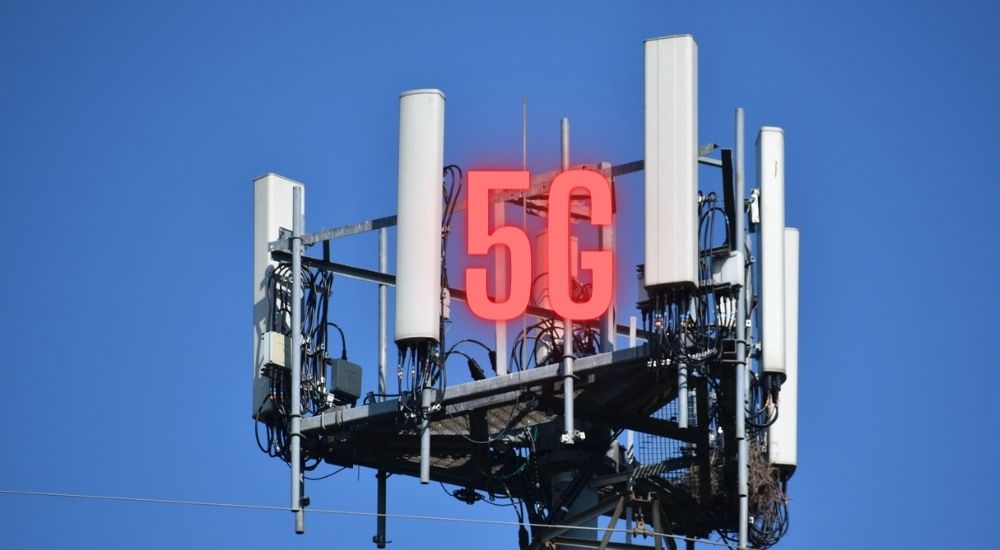
Wireless Broadband, AI, VR, streaming, Industry automation, etc. are the next dominant digital spaces. 5G can handle huge amounts of video streaming users, Massive IoT devices, and ultra-low latency applications.
Here is the Radio Frequency Policy for Telecommunication Services (Allocation and Price) 2080. You can also download it below.
Radio Frequency Policy in essence
Frequency is a nation’s one of the most key assets and telecommunication is an extremely vital service. From the perspective of the digital Nepal vision and also the business and security purposes, the policy remains a driver. Its successful implementation ensures a healthy competitive telecommunication field, optimum use of frequencies, and quality communication services.
Given that there are only two players in Nepal’s telecommunication industry, it’s even more significant that the government encourages a level playing field for all and also encourages new candidates to enter the market.


